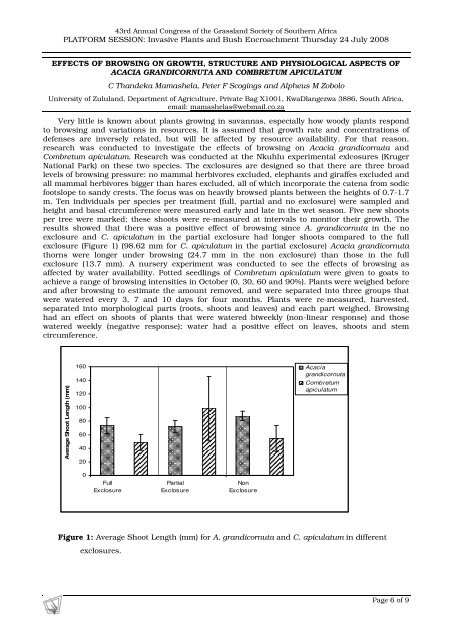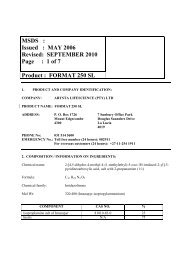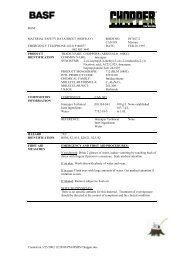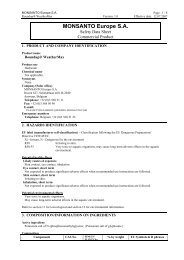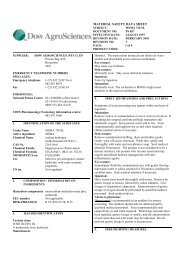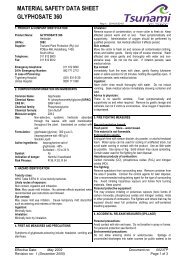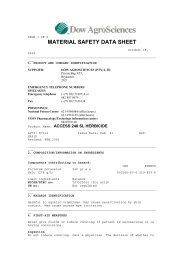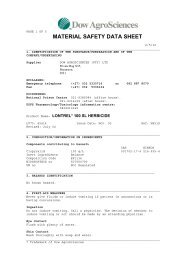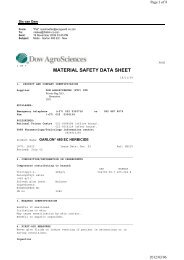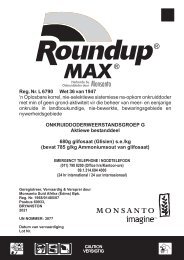Invasive Plants and Bush Encroachment
Invasive Plants and Bush Encroachment
Invasive Plants and Bush Encroachment
Create successful ePaper yourself
Turn your PDF publications into a flip-book with our unique Google optimized e-Paper software.
43rd Annual Congress of the Grassl<strong>and</strong> Society of Southern Africa<br />
PLATFORM SESSION: <strong>Invasive</strong> <strong>Plants</strong> <strong>and</strong> <strong>Bush</strong> <strong>Encroachment</strong> Thursday 24 July 2008<br />
EFFECTS OF BROWSING ON GROWTH, STRUCTURE AND PHYSIOLOGICAL ASPECTS OF<br />
ACACIA GRANDICORNUTA AND COMBRETUM APICULATUM<br />
C Th<strong>and</strong>eka Mamashela, Peter F Scogings <strong>and</strong> Alpheus M Zobolo<br />
University of Zulul<strong>and</strong>, Department of Agriculture, Private Bag X1001, KwaDlangezwa 3886, South Africa,<br />
email: mamashelas@webmail.co.za<br />
Very little is known about plants growing in savannas, especially how woody plants respond<br />
to browsing <strong>and</strong> variations in resources. It is assumed that growth rate <strong>and</strong> concentrations of<br />
defenses are inversely related, but will be affected by resource availability. For that reason,<br />
research was conducted to investigate the effects of browsing on Acacia gr<strong>and</strong>icornuta <strong>and</strong><br />
Combretum apiculatum. Research was conducted at the Nkuhlu experimental exlcosures (Kruger<br />
National Park) on these two species. The exclosures are designed so that there are three broad<br />
levels of browsing pressure: no mammal herbivores excluded, elephants <strong>and</strong> giraffes excluded <strong>and</strong><br />
all mammal herbivores bigger than hares excluded, all of which incorporate the catena from sodic<br />
footslope to s<strong>and</strong>y crests. The focus was on heavily browsed plants between the heights of 0.7-1.7<br />
m. Ten individuals per species per treatment (full, partial <strong>and</strong> no exclosure) were sampled <strong>and</strong><br />
height <strong>and</strong> basal circumference were measured early <strong>and</strong> late in the wet season. Five new shoots<br />
per tree were marked; these shoots were re-measured at intervals to monitor their growth. The<br />
results showed that there was a positive effect of browsing since A. gr<strong>and</strong>icornuta in the no<br />
exclosure <strong>and</strong> C. apiculatum in the partial exclosure had longer shoots compared to the full<br />
exclosure (Figure 1) (98.62 mm for C. apiculatum in the partial exclosure) Acacia gr<strong>and</strong>icornuta<br />
thorns were longer under browsing (24.7 mm in the non exclosure) than those in the full<br />
exclosure (13.7 mm). A nursery experiment was conducted to see the effects of browsing as<br />
affected by water availability. Potted seedlings of Combretum apiculatum were given to goats to<br />
achieve a range of browsing intensities in October (0, 30, 60 <strong>and</strong> 90%). <strong>Plants</strong> were weighed before<br />
<strong>and</strong> after browsing to estimate the amount removed, <strong>and</strong> were separated into three groups that<br />
were watered every 3, 7 <strong>and</strong> 10 days for four months. <strong>Plants</strong> were re-measured, harvested,<br />
separated into morphological parts (roots, shoots <strong>and</strong> leaves) <strong>and</strong> each part weighed. Browsing<br />
had an effect on shoots of plants that were watered biweekly (non-linear response) <strong>and</strong> those<br />
watered weekly (negative response); water had a positive effect on leaves, shoots <strong>and</strong> stem<br />
circumference.<br />
Average Shoot Length (mm)<br />
160<br />
140<br />
120<br />
100<br />
80<br />
60<br />
40<br />
20<br />
Acacia<br />
gr<strong>and</strong>icornuta<br />
Combretum<br />
apiculatum<br />
0<br />
Full<br />
Exclosure<br />
Partial<br />
Exclosure<br />
Non<br />
Exclosure<br />
Figure 1: Average Shoot Length (mm) for A. gr<strong>and</strong>icornuta <strong>and</strong> C. apiculatum in different<br />
exclosures.<br />
Page 6 of 9


